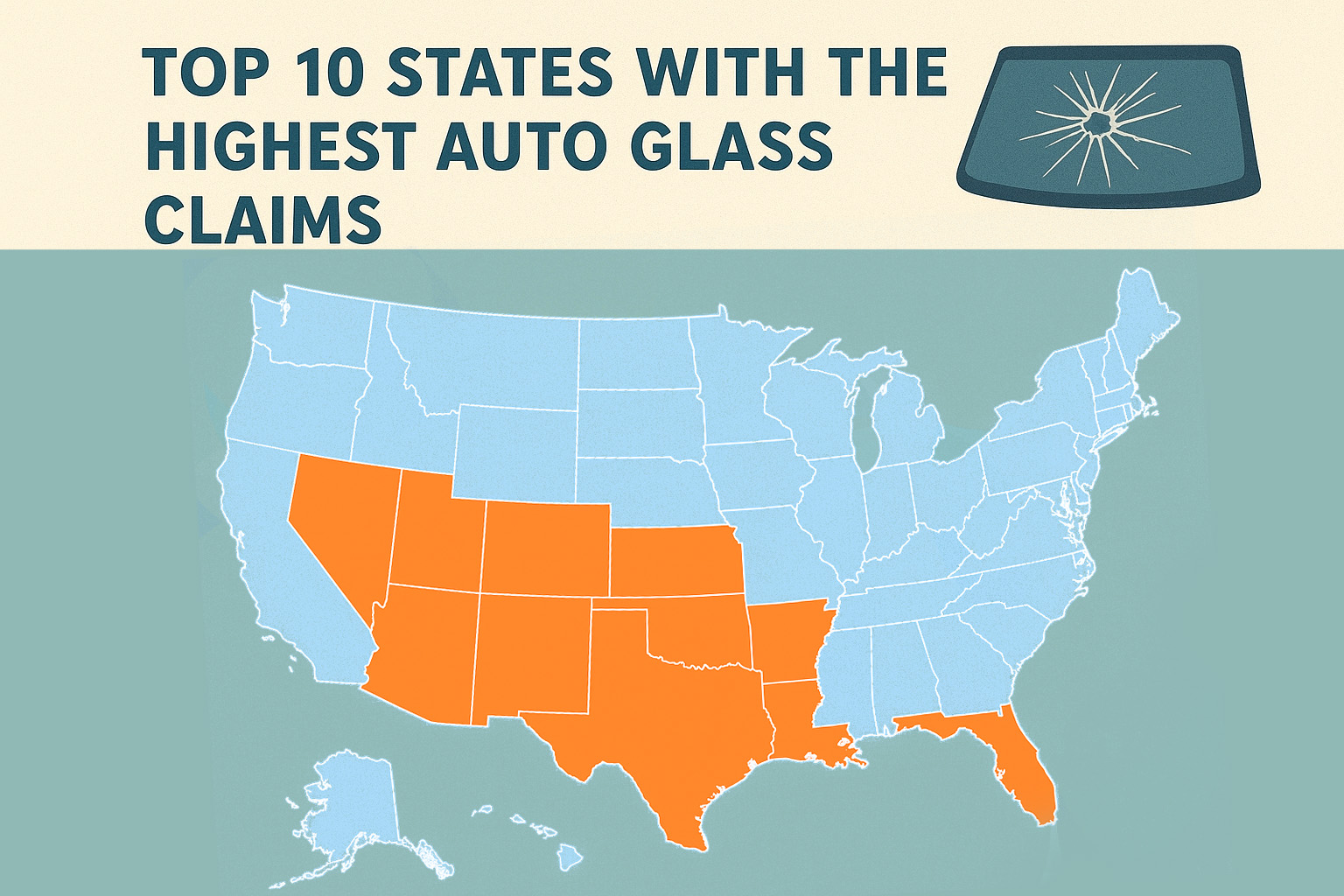Where Auto Glass Damage Happens Most
Windshield damage is one of the most common vehicle insurance claims in the U.S., and depending on where you live, your chances of needing a repair or replacement can skyrocket. From rock chips on desert highways to hailstorms in the Midwest, each state faces unique conditions that put auto glass at risk.
To help you understand where and why auto glass claims are so frequent, we’ve broken down the top 10 states with the highest rates of auto glass claims, along with the most common causes in each.
1. Arizona
Why It Ranks High:
Arizona leads the nation in auto glass claims year after year. The combination of extreme heat, dusty desert roads, and loose gravel from constant construction creates a perfect storm for windshield damage. The rapid temperature swings from 110°F afternoons to cool desert nights, can make small chips spread into full cracks overnight.
Common Causes:
- Loose gravel and debris on highways
- Sudden temperature fluctuations
- UV and heat-related stress cracks
2. Florida
Why It Ranks High:
Florida’s mix of heavy traffic, unpredictable weather, and coastal salt air contributes to a high number of glass claims. Frequent thunderstorms and hurricane debris increase the risk of windshield and window damage.
Common Causes:
- Flying debris from high winds and storms
- Coastal corrosion and humidity
- Busy highways and road construction
3. Texas
Why It Ranks High:
With its massive size and wide range of climates, Texas drivers face everything from hailstorms in the north to high-speed highway debris in the south. Many regions also have gravel shoulders that send rocks flying at windshields.
Common Causes:
- Severe hailstorms and tornado debris
- Highways with gravel or loose rock
- Sudden temperature shifts
4. Colorado
Why It Ranks High:
Colorado’s mountain driving, fluctuating temperatures, and heavy use of road sand during winter are major factors. Chips from tiny pebbles kicked up on icy roads are extremely common, and the cold can make cracks spread quickly.
Common Causes:
- Sand and gravel used for snow traction
- Ice expansion and temperature stress
- Mountain highway debris
5. Nevada
Why It Ranks High:
Similar to Arizona, Nevada’s arid desert environment creates constant exposure to airborne dust, sand, and rocks. Urban expansion and construction zones around Las Vegas and Reno further increase the risk.
Common Causes:
- Gravel and debris on desert roads
- Construction zones
- Heat-induced cracking
6. California
Why It Ranks High:
California’s long stretches of busy freeways and varying climates, from deserts to mountains, make windshield damage a regular occurrence. Wildfires and construction also contribute to flying debris and ash that can scratch or weaken glass.
Common Causes:
- Highway construction debris
- Wildfire-related ash and dust
- Vibrations from heavy traffic
7. Oklahoma
Why It Ranks High:
Oklahoma’s tornado-prone weather and frequent hailstorms make it a hotspot for auto glass claims. Even outside storm season, rural dirt roads and high winds cause plenty of rock and debris damage.
Common Causes:
- Hail and storm debris
- Rural gravel roads
- High winds carrying dust and small rocks
8. Kansas
Why It Ranks High:
Kansas has one of the highest rates of hail damage in the country. Between unpredictable spring storms and rough rural roads, it’s no surprise auto glass claims stay consistently high.
Common Causes:
- Severe hailstorms
- Gravel road travel
- Storm-season debris
9. Utah
Why It Ranks High:
Utah’s rugged terrain and mix of desert and mountain climates make it tough on auto glass. Road crews use gravel to manage snow and ice, and many drivers commute long distances on rural highways, increasing chip risks.
Common Causes:
- Road salt and gravel in winter
- Temperature extremes
- Long highway commutes
10. New Mexico
Why It Ranks High:
New Mexico’s dry climate, desert roads, and frequent construction zones make rock chips a daily occurrence for many drivers. The fine dust in the air can also cause small scratches that weaken glass over time.
Common Causes:
- Loose gravel and desert terrain
- Construction and rural road debris
- UV damage from year-round sun exposure
Why Choosing a Trusted Shop Matters
No matter where you live, a damaged windshield is more than an inconvenience, it’s a safety hazard. Modern vehicles often have ADAS (Advanced Driver Assistance Systems) built into the glass, such as lane-keeping or collision sensors. An improper installation or poor-quality replacement can cause those systems to malfunction, putting you and others at risk.
That’s why it’s essential to choose a certified, reputable auto glass shop that uses OEM-quality materials and proper calibration techniques.
How Auto Glass Estimator Makes It Easy
At Auto Glass Estimator, we’re committed to helping drivers get safe, reliable, and affordable repairs without the guesswork.
Our free online quote tool lets you instantly compare prices and services from up to three trusted local shops in your area.
With just a few clicks, you can:
✅ Get accurate price estimates for your vehicle’s make and model
✅ See verified shop ratings and certifications
✅ Schedule repairs or replacements at your convenience
Whether you’re in Arizona, Florida, or anywhere else in the U.S., Auto Glass Estimator helps you find the right shop fast, so you can get back on the road safely.
Final Thoughts
Windshield damage may be unavoidable in some climates, but finding quality repair shouldn’t be a struggle. By understanding which states face the toughest conditions (and why), you can stay better prepared and act quickly when chips or cracks appear.
Use Auto Glass Estimator today to compare trusted shops near you and get your free quote in minutes.

